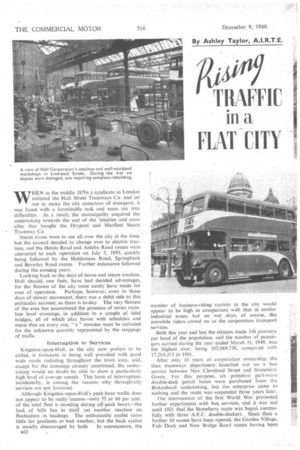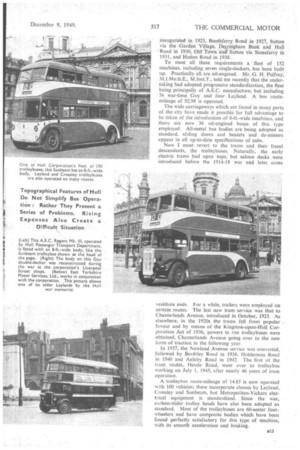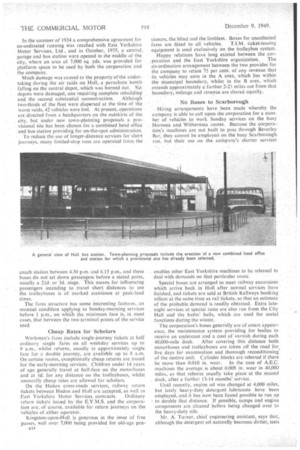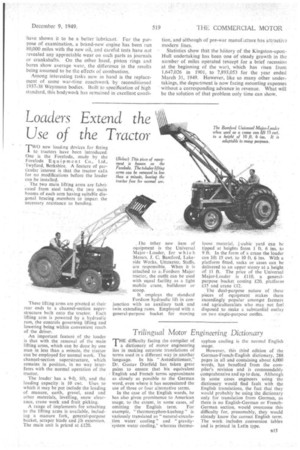TRAFFIC in a FLAT CITY
Page 46

Page 47

Page 48

Page 49

If you've noticed an error in this article please click here to report it so we can fix it.
WHEN in the middle 1870s a syndicate in London initiated the Hull Street Tramways Co. and set out to make the city conscious of transport, it was faced with a formidable task and soon ran into difficulties. As a result, the municipality acquired the undertaking towards the end of the 'nineties and soon after that bought the Drypool and Marfleet Steam
Tramway ,Co. .
Steam trams were in use all over the city at the time, but the council decided to change over to electric traction, and the Hessle Road and Anlaby Road routes were converted to such operation on July 5, 1899, quickly being followed by the Holderness Road, Springbank and Beverley Road routes. Further extensions followed during the ensuing years.
Looking back to the days of horse and steam traction. Hull should, one feels, have had decided advantages, for the flatness of the city must surely have made for ease of operation. Perhaps, however, even in those days of slower movement, there was a debit side to this particular account, as there is to-day. The very flatness of the area has necessitated the presence of seven mainline level crossings, in addition to a couple of tidal bridges, all of which play havoc with schedules and mean that on every run, " x" minutes must be included for the unknown quantity represented by the stoppage of traffic
Interruption to Services
Kingston-upon-Hull, as the city now prefers to be called, is fortunate in being well provided with good wide roads radiating throughout the town area, and, except for the crossings already mentioned, the undertaking would no doubt be able to show a particularly high level of average speeds. This form of interruption, incidentally, is among the reasons why through-city services are not favoured Although Kingston-upon-Hull's peak-hour traflic does not appear to be really intense—only 55 or 60 per cent. of the total fleet is standing during or-peak hours—the lack of hills has in itself yet another reaction on fluctuation in loadings. The enthusiastic cyclist cares little for gradients or bad weather, but the hack cyclist is usually discouraged by both In consequence, the B12 number of business-riding cyclists in the city would appear to be high in comparison with that in similar industrial areas, but on wet jays, of course, the erstwhile riders crowd on to the corporation transport services.
Both this year and last the citizens made 346 journeys per head of the population. and the number of passengers carried during the year ended March 31, 1949, was the highest ever, being 102,069,738, comp.:tied with 17,264,013 in 1901.
After only 10 years of corporation ownership. the then tramways department launched out on a bus service between New Cleveland Street and Stoneferrv Green. For this purpose, six primitive part-worn double-deck petrol buses were purchased from the Birkenhead undertaking, but the enterprise came to nothing and the route was suspended three years later.
The intervention of the first World War prevented further experiments_ with bus, services, and it was not until 1921 that the Stoneferry route Was. begun successfully with three A.E.C. double-decker& Since then a further 10 routes have been opened, the Garden Village, Fish Dock and New Bridge Road routes having been inaugurated in 1923, Boothferry. Road in 1927, Sutton via the Garden Village, Lierringham Bank and Hail Road in 1930, Old 'Town anti Sutton via Stoneferry th 1931, and Hedon Road in 1938.
To meet all these requirements a fleet of 152 machines, including seven single-deckers, has been built up. Practically all are oil-engined. Mr. G. H. PulfreY, M.Inst.T., told me recently that the undertaking had adopted progressive standardization, the fleet being principally of A.E.C. manufacture, but including 36 war-time Guy and four Leyland. A bus routemileage of 92.98 is operated The wide carriageways which are found in many parts of the city have made it possible for full advantage to be taken of the introduction of 8-ft.-wide machines, and there are now 36 oil-engined buses of this type employed. All-metal bus bodies are being adopted as standard, -sliding doors and heaters and de-misters appear in all up-to-date specifications of cabs.
Now I must revert to the trams and their lineal descendants, the trolleybuses. Naturally, the early electric trams had open tops, but saloon decks were introduced before the 1914-18 war and later. came
vestibule ends. For a while, trailers were employed on certain routes. The last new tram service was that to Chanterlands Avenue, introduced in October, 1925. As elsewhere, in the 1920s the trams fell from popular favour and by means of the Kingston-upon-Hull Corporation Act of 1936, powers to run trolleybuses were obtained, Chanterlands Avenue going over to the new form of traction in the following year.
In 1937, the Newland Avenue service was converted, followed by Beverley Road in 1938, Holderness Road in 1940 and Anlaby Road in 1942. The first of the tram routes, Hessle Road, went over to trolleybus working on July I, 1945, after nearly 46 years of tram operation.
A trolleybus route-mileage of 14.85 is now operated with 100 vehicles; these incorporate chassis by Leyland, Crossley and Sunbeam, but Metropolitan-Vickers electrical equipment is standardized. Since the war, carbon-slider trolley heads have also been adopted as standard. Most of the trolleybuses are 60-seater fourwheelers and have composite bodies which have been found perfectly satisfactory for this type of machine, with its smooth acceleration and braking.
In the summer of 1934 a comprehensive agreement for co-ordinated running was reached with East Yorkshire Motor Services, Ltd., and in October, 1935, a central, garage and bus station were opened in the middle of the city, where an area of 7,000 sq. yds. was provided for platform space to be used by both the corporation and the company.
Much damage was caused to the property of the undertaking during the air raids on Hull, a parachute bornh falling on the central depot, which was burned out. Sx depots were damaged, one requiring complete rebuilding and the second substantial reconstruction. Although two-thirds of the fleet were dispersed at the time of the worst raids, 42 vehicles were lost. At present, operations are directed-from a headquarters on the outskirts of the city, but under new town-planning proposals a provisional site has been chosen for a combined head office and bus station providing for on-the-spot administration.
To reduce the use of longer-distarice services for silo:in journeys, many limited-stop runs are operated from the coach station between 4.30 p.m. and 6.15 p.m., and these buses do not set down passengers before a stated point, usually a 21d. or 3d. stage. This means for influencing passengers intending to travel short distances to use the trolleybuses is of marked assistance at peak-load times.
The fares structure has some interesting features, an unusual condition applying to Sunday-morning services before 1 p.m., on which the minimum fare is, in most cases, that between the two terminal points of the service used.
Cheap Rates for Scholars
Workmen's fares include single-journey tickets at half ordinary single fares on all weekday services up to 9 a.m., whilst returns, usually at approximately single fare for a double journey, are available up to 8 a.m. On certain routes, exceptionally cheap returns are issued for the early-morning services: Children under 14 years of age generally travel at half-fare on the motorbuses and at id. for any distance on the trolleybuses, whilst unusually cheap rates are allowed for scholars.
On the Hedon cross-roads services, railway return tickets between Hedon and Hull are accepted, as well as ,East Yorkshire Motor Services contracts. Ordinary return tickets issued by the E.Y.M.S. and the corporation are, of course, available for return journeys on the vehicles of either operatcir.
Kingston-upon-Hull is generous in the issue of free passes, well over 7,000 being provided for old-age penn sioners, the blind and the limbless. Boxes for uncollected fares are fitted to all vehicles. T.I.M. ticket-issuing equipment is used exclusively on the trolleybus system. Happy relations have long existed between the cor poration and. the East Yorkshire organization. The co-ordination .arrangement between the two provides for the company to retain 75 per cent. of any-revenue that its vehicles may earn in the A area, which lies within the municipal boundary, whilst in the B area, which extends approximately a further 2-21miles out from that boundary, mileage and revemie are shared equally.
No Buses to Scarborough
Hiring arrangements have been made whereby the company is'able to call upon the corporation for a number of vehicles to Work Sunday services on the busy Hornsea and Withernsea routes. Because the corporation's' machines are not built to pass through Beverley Bar, they cannot be employed on the busy Scarborough run, but their use on the company's shorter services enables other East Yorkshire machines to be released to deal with demands on that particular route.
Special buses are arranged to meet railway excursions which arrive back in Hull after normal services have.
finished, and tickets are sold at British Rallways booking offices at the sarne time as rail tickets, so that an estimate of the probable demand is readily obtained. Extra late night services at special rates are also run from the City Hall and the baths' halls, which are Used for social functions during the winter.
The corporation's buses generally are of smart appearance, the maintenance system providing for bodies to receive an undercoat and a coat of varnish during each 40,000-mile dock. After covering this distance both motorbuses and trolleybuses are taken off the road for five days for examination and thorough reconditioning of the motive unit. Cylinder blocks are rebored if there be more than 0.010 in. wear. In the case of A.E.C.
machines the average is about 0.008 in. wear in 40,000 miles,, so that rebores usually take place at the second dock, after a further 13-14 months' service.
Until recently, engine oil was changed at 4,000 miles, but lately heavy-duty detergent lubricants have been employed, and it has now been found possible to run up to double that distance. If possible, sumps and engine components are cleaned before being changed over to the heavy-duty oils.
Mr. A. Turner, chief engineering assistant, says that, although the detergent oil naturally becomes dirtier, tests
have shown it to be a better -lubricant. For the purpose of examination, a brand-new engine has been run 80,000 miles with the new oil, and careful tests have not revealed any appreciable wear on such parts as journals or crankshafts. On the other hand, piston rings and bores show average wear, the difference in the results being assumed to be the effects of combustion.
Among interesting tasks now in hand is the replacement of some war-time coachwork by reconditioned 1937-38 Weymann bodies. Built to specification of high standard, this bodywork has remained in excellent condi tion, and although of pre-war manufacture has attractive modern lines.
Statistics show that the history of the Kingston-uponHull undertaking has been one of steady growth in the number of miles operated (except for a brief recession at the beginning of the war), which has risen from 1,647,026 in 1901, to 7.893,053 for the year ended March 31, 1949_ However, like so many other under7 takings, the department is now facing mounting expenses without a corresponding advance in revenue. What will be the solution of that problem only time can show.




























































































